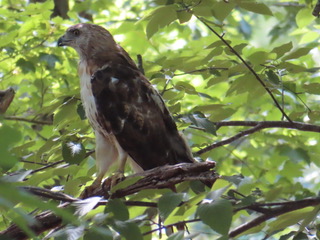Breeding Bird Survey, Brockton, MA
- MYBC
- Jul 17, 2022
- 3 min read


On Saturday, July 16th the Massachusetts Young Birder’s Club was lucky enough to participate in a mock breeding bird survey of D.W. Field Park with Manomet Summer Stewardship Interns Emilia Skogen and Josephine Tagestad. Due to the high number of people using the park on a Saturday morning, some club members had to park in a nearby lot down the road. Although this resulted in a little bit of an extra walk, it meant that these birders got to bump into an unexpected Spotted sandpiper on the walk over!
Once the whole group was together, Emilia and Josephine explained the importance of breeding bird surveys. Even though there isn’t much migration activity in the middle of the summer, there is still a lot that we can see and learn from local nesting birds! After we got an overview of what to look for, we were given a breeding bird code cheat sheet and began our mock survey.
We set out along the paved D.W. Field Parkway toward the fieldstone observation tower. Walking along the edge of Upper Porter Pond, we were greeted by Song sparrows, Redwing blackbirds and Catbirds and even saw a Song sparrow nest that Emilia and Josephine had

watched chicks fledge from! One important distinction we learned to observe is whether to note a breeding bird behavior if a bird is not in its breeding habitat. For instance, we saw a Redwing blackbird foraging in an open grassy area. Because this is not typical nesting habitat for Redwing blackbirds, we did not mark it as a breeding behavior.
Immediately across from Upper Porter Pond we became mesmerized by a vibrant yellow goldfinch contrasting with a dark green pine tree it was perched in. As we made our way to
the fieldstone observation tower, we crossed paths with Chipping sparrows, a couple of Baltimore orioles, and a Tufted titmouse singing in the distance. Once at the tower, we were able to get a great look at quite a few flocks of local golfers, but became quickly distracted by a perched Eastern phoebe doing it’s classic tail bobbing on a dead oak branch.
Continuing down the road, we encountered a Red-tailed hawk who swooped into the woods right behind us! We became part of a chain of creatures that were immediately aware of the hawk’s presence in the forest. As we watched, the hawk began being mobbed by Tufted titmice and Blue jays and it wasn’t long before it moved on to a more peaceful area, probably.
We then looped back around to the edge of Waldo Pond and began our trek back. Looking out over Waldo Pond, we were able to see a pair of adult Mute swans with three cygnets as well as a couple of Mallards and a handful of Geese. We were able to compare the cygnets we were seeing at Waldo Pond to three cygnets we had been watching at Upper Porter Pond. Because of their lack of floofiness and more white coloration, we were able to determine that the cygnets on Waldo Pond were probably a little bit older that those on Upper Porter Pond.

Continuing towards the cars, we were greeted by an American robin delivering food to its nest, an empty nest in a tree, and even a shrew that one club member noticed from just a couple of leaves rustling on the forest floor! Once at the cars, we recapped our eBird list and headed out for the day. For the group walking back to the further parking lot, we saw the surprise Spotted sandpiper from the beginning of the day and were even more surprised to see a Ring-necked duck floating in the middle of the pond!
The whole walk was filled with thoughtful observations and insights into the lives of local nesting birds!






コメント